“Founded in 2010, The Unpublished Games Network, called Unpub, is a growing community of game designers, publishers, players, retailers and artists working towards the creation of new and unique table top games that will keep people entertained for generations to come.”
Over the weekend of February 6-8, we attended the Unpublished Games Network Convention (aka UNPUB 5) in Baltimore, MD. Over a 1,000 gamers gathered for playtesting and open gaming. It was truly awesome to see so much support for the designers and their unpublished games/prototypes.
[su_youtube url=”https://www.youtube.com/watch?v=ChZ6fyNVEII”]
Before we get into the games, I just wanted to stress that our write-ups are essentially first impressions. And first impressions in a convention setting at that. All of the prototypes we played at Unpub were in varying stages of development. Some were signed and about to be published or kickstarted; others were in the early stages of development and simply looking to get in some play testing. No matter the stage, one thing stood true for all the of games – the designers were still extremely receptive to feedback. Here are a few of the games we got to play and our initial thoughts on each.
Made from Scratch
Designer: Nicholas Richards & William Pogue | Players: 2-4 | Time: 45-60 mins | Rules: N/A
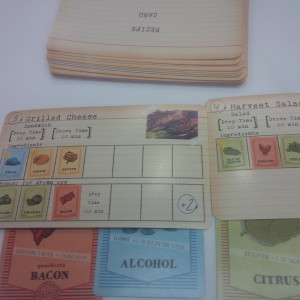 In Made From Scratch, you are a chef competing for access to ingredients, recipes, and even cooking appliances, like a cut-throat version of the TV show Chopped. With a fun theme and a charming design, this is a prototype that was as enjoyable to look at as to play. Players draft ingredients from a freshly laid-out market every turn, or may choose to draw blindly if nothing they desire is in stock. With these ingredients in hand, players then must match them with the available recipes on display, competing to hold the majority ‘influence’ on the dish in order to claim it for themselves. Once finished, each recipe must be moved through the kitchen, first being prepped on the counter for a certain number of turns, before moving to a stove or the oven to cook. Only once a dish is fully cooked will the chef receive points for their creation! Of course, spaces in the kitchen are limited, so it’d be a shame if your dish sat there on the counter, spoiling, while someone else held up one of the oven spaces with their meatloaf… wouldn’t it?
In Made From Scratch, you are a chef competing for access to ingredients, recipes, and even cooking appliances, like a cut-throat version of the TV show Chopped. With a fun theme and a charming design, this is a prototype that was as enjoyable to look at as to play. Players draft ingredients from a freshly laid-out market every turn, or may choose to draw blindly if nothing they desire is in stock. With these ingredients in hand, players then must match them with the available recipes on display, competing to hold the majority ‘influence’ on the dish in order to claim it for themselves. Once finished, each recipe must be moved through the kitchen, first being prepped on the counter for a certain number of turns, before moving to a stove or the oven to cook. Only once a dish is fully cooked will the chef receive points for their creation! Of course, spaces in the kitchen are limited, so it’d be a shame if your dish sat there on the counter, spoiling, while someone else held up one of the oven spaces with their meatloaf… wouldn’t it?
Smee: This was the first game I played that weekend, and quite possibly the most interesting, as well, needing only a bit more polish. One concern I had involved the sheer variety of ingredients that were available. While it gave verisimilitude to the theme, and there were ‘Substitution’ cards that allowed you to use, say, rice instead of pasta, I feel that the categories could be tightened, or substitutions be allowed without having to use another precious card.
Steebin: I had a great time with this game. It was very easy to learn and you knew exactly what you were trying to accomplish. This game offers a ton of player interaction and you can really stick it to your opponents using the action cards or adding some secret ingredients to tip the scales in your favor. The game time was a little on the long side and I was stuck holding cards in my hand because most of my ingredients did not match any of the recipes on the board or my opponents were able to claim them first. I still had a blast with this one and will be looking for it to hit Kickstarter soon.
Kelly: I loved this game! It was excellent. The game ended up being kind of long – I think it took us an hour and a half to play through – but I never felt like it was dragging. The aesthetic design of the game was fantastic, reminiscent of old recipe books and my grandmother’s kitchen (if I’m being honest) and I loved it so much. The recipes were neat and exhibited a variety of foods (cream of crab soup – yum!) and the flexibility provided by cards like “Substitution” and “Short Cut,” or even “Borrow A Cup of Sugar,” which lets you steal someone else’s ingredients.
Club Zen
Designer: T.C. Petty III | Players: 3-5 | Time: 90-120 mins | Rules: Click Here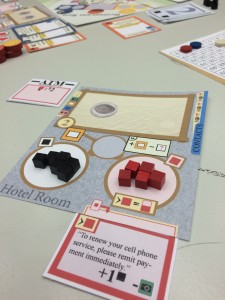
Time to unwind and plan a vacation! Massages, dinner with friends, meditation, night clubbing and all the wonderfully relaxing activities one might expect, with one catch: it’s a working vacation and you can’t completely escape the stresses of real life. Club Zen is a worker placement game in which you manage work and emotional stress by planning activities at a Caribbean resort over the course of a one week stay. The most relaxed player at the end of the game wins.
Tiff:Club Zen has been an unpublished white whale for me, so I was very excited to sit down and finally play it after two years of trying! The unique vacation theme really drew me in, but the gameplay turned out to be just as unique. At the core, it is simple worker placement; players take turns placing tokens representing the morning, afternoon, and evening schedules, then resolve the actions for each space they placed on.
The special thing about this game is that players can- and are encouraged to- place on the same locations together! I might get to reduce one stress if I eat dinner solo, but I’ll get to reduce two if I have a friend come along. This invites players to interact when the outcome can be mutually beneficial and results in very natural sounding conversations across the table. I found myself asking opponents, “Does anyone want to have lunch with me?” It was exceedingly immersive. Speaking of immersion, the stress you accumulate in the game can feel real! Event cards come out each round, adding stress to your pool if you don’t meet certain requirements and I started to panic a bit when my work stress started to overflow. The irony of this was delightful! Club Zen really messed with my sense of loss aversion in a humorous, light-hearted kind of way, making it a fun take on a medium-heavy strategy game!
Cosmic Kaboom
Designer: Matt Loomis | Players: 2-4 | Time: 30 mins | Rules: N/A
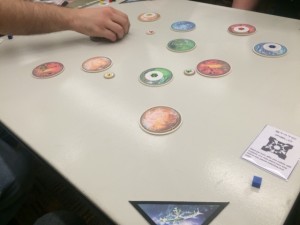 Cosmic Kaboom is a dexterity flicking game where players fly around space collecting energy to power up space bombs and eradicate the planets of their enemies. Each player controls three planets in their color scattered throughout the “board.” One of these planets will house an energy token which supplies players with an energy of that color when their ship is flicked into this planet. After an energy of each player color is collected, you may toss the cosmic bomb onto the board in an attempt to blow up the other player’s planets. Each planet has a VP value (shown on the back of the planet) that you earn when blowing it up. Variable player powers are given to players throughout the game which provide bonuses to aid in your conquest. The game continues until one player has lost all of their planets. Whoever has the most points, is the ruler of the universe!
Cosmic Kaboom is a dexterity flicking game where players fly around space collecting energy to power up space bombs and eradicate the planets of their enemies. Each player controls three planets in their color scattered throughout the “board.” One of these planets will house an energy token which supplies players with an energy of that color when their ship is flicked into this planet. After an energy of each player color is collected, you may toss the cosmic bomb onto the board in an attempt to blow up the other player’s planets. Each planet has a VP value (shown on the back of the planet) that you earn when blowing it up. Variable player powers are given to players throughout the game which provide bonuses to aid in your conquest. The game continues until one player has lost all of their planets. Whoever has the most points, is the ruler of the universe!
Dan: Dexterity games are my jam and Mr. Loomis did not let me down with this one. The game was simple to setup and even easier to explain. The variable powers provided a little twist and allowed you to produce some really satisfying combos on your turn. Similar to my favorite dexterity game, Elk Fest (review here), the board can be expanded to your liking for an added challenge. Overall, I really enjoyed the sheer fun that was packaged into this game. Keep your eyes peeled for this on Kickstarter in the coming months! (Pssst – Matt, send us a preview copy!)
Note: We talk about Cosmic Kaboom in our podcast Episode 16 Unpub 5 wrap-up. If you didn’t click on the link before, do it now!
Milkman: The Dice Game
Designer: Josh Mills | Players: 2-5 | Time: 30-60 mins | Rules: N/A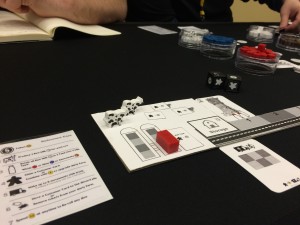
In Milkman: The Dice Game you enter the competitive world of milk production, where you will control every aspect of the process “from cow to cup.” Throughout the game, you use your dice to expand your herd of cows, produce delicious milk, and deliver it to anxiously awaiting customers. The player who delivers the most milk and runs their milk empire most efficiently will collect the most victory points and reign supreme!
Tiff: This may be my favorite game of Unpub 5! I love that the rules are quick and easy to learn, largely because the theme and mechanisms are integrated in an intuitive way. When I roll a cow, one of my cows produces raw milk, when I roll a bottle I can process that raw milk into my choice of skim, chocolate, or whole milk depending on my orders, and once it’s processed, I need truck symbols to deliver the milk. It’s a very simple combination of set collection and pick up and delivery. It’s fun to deliver the milk, Coal Baron-style, by sliding your milk truck down a path and using each truck symbol as an action point.
One aspect that sets this game apart from other dice games is the distinct lack of down time. There is always something for players to do even when it’s not their turn because each player has two personal dice that they roll whether they are the active player or not. Because of this, the game goes by fast. It played in slightly under an hour, but felt like even less. All in all, I think this one will shape up to be a great game for when you crave strategic planning, but don’t have the time for a heavier game. I have one suggestion for Mr. Mills: An egg nog expansion for the holidays!
Odd Socks
Designer: John du Bois | Players: 2-4 | Time: 5-10 mins | Rules: Click Here | PNP: Click Here
Ahh, that pesky matchless sock! There always seems to be one, no matter how careful you are! In Odd Socks, you are looking for that lonely sock and trying to get it into your basket by the end of the game through card play and deduction.
Tiff: Everyone starts with one face-up sock card in their basket and a handful of socks. On your turn, you either place a card face up in your basket and perform its special action, or place it face down and end your turn. Special actions allow you to swap cards from your hand or basket with other players, look at your opponents’ cards, or reveal face-down cards; all in an effort to narrow down where the one sock might be. I’m not usually a fan of deduction games or micro games, but Odd Socks is both and I enjoy it! Part of that is the adorable theme, and not to mention, the fact that the rules are under a page and super approachable. I can definitely see it as a great introduction to deduction style games; it only takes 10 minutes and I found myself wanting to play again immediately after it was over.
Best Treehouse Ever
Designer: Scott Almes| Players: 2-4 | Time: 20 mins | Rules: N/A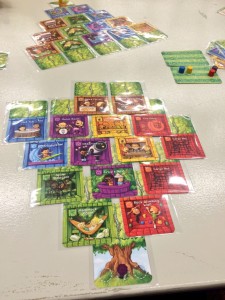
In Best Treehouse Ever, players compete to build their best treehouse, outfitting their treehouse with cool rooms, while also making sure that their tree doesn’t tip over and that their rooms are more impressive than all of their friends’ rooms at the end of the game. Building takes place over three weeks/rounds, and in each round, players use card drafting and spatial reasoning to add five new rooms to their treehouse. Players must pay attention to the other treehouses being built, since they take turns determining which types of rooms score for everyone at the end of each round. At the end of the third week, the winner is the player with the best treehouse ever!
Dan: Scott Almes. Done. But seriously, Scott has made a living off of great games in small packages and Best Treehouse Ever is no exception. The game utilizes a drafting mechanic similar to light-weight fillers such as Sushi Go and Fairy Tale with an added spacial element. What color room and where you place it on your treehouse must be taken into account when selecting your cards as there are color and weight distribution restrictions (so your treehouse doesn’t fall over, duh). The weight distribution mechanic is very simple but adds a solid decision point when constructing the layers of your tree. The copy we played had near final artwork from the awesome Adam McIver with the different treehouse rooms adding a whimsical feel to the game. This game should be on Kickstarter in late March so stay tuned for more.
Note: We talk about Best Treehouse Ever in our podcast Episode 16 Unpub 5 wrap-up. Make sure you check it out!
Gunslingin’ Ramblers
Designer: Jason Slingerland | Players: 2-6 | Time: 30 mins | Rules: N/A
You are a gunslinger, hired to play poker for some big Wild West trail boss. You are given several cards with poker hands and a designation of whether or not you’re cheating (because what cowboy is gonna play it straight all the time) and some money for betting. Game play progresses in rounds in which you play your hands, call each other out, roll dice to determine if you discover a cheater and then to participate in a shoot ‘em up gunfight. If you’re the winner of the fight, you take the pot and claim the bounty on your opponent. Winners buy everyone shots of whiskey to try to knock them out and then play continues – play more hands, shoot more guns and drink more shots. At the end of the game, whoever took the most shots and had the most money stashed under their mattress wins the game!
Smee: This was a game that was interesting at first blush, but the lack of options and the luck of the ‘combat’ rolls left me desiring a stiff drink of my own. Maybe I’m just being salty, but when you lose every single dice roll, despite consistently optimizing yourself for them, the charm begins to wear off. Especially when your only (and obvious) choice during a turn is that dice roll.
Kelly B!: Initially this game was pretty fun. You’re trying to figure out which poker hand you’d like to play, trying to guess whether someone is cheating and then you’re rolling the dice to try to shoot someone in a bar fight. The game moved quickly and it seemed to be pretty even – minus the fact that Smee kept rolling terribly. As I’ve thought back on the mechanics of this game, I’ve come to realize that the game comes down to little more than rolling the dice against one another. Some of the character cards give you special abilities (like being able to re-roll one of your dice) but the betting is the same round to round, as opposed to players betting on the hand they are deciding to play. There just wasn’t much benefit to opting out of attempting to discover a cheater.
This game is reminiscent of The Outlaws in that it was, on the whole, kind of dissatisfying. Overall, I would have liked to see you have a bit more flexibility and control over your fate in the Wild, Wild West. Perhaps by allowing you to decide what you’d like to bet, installing a penalty for cheating (in addition to awarding a benefit for being falsely accused of cheating), and/or making the decision to cheat yours as opposed to your cards forcing your hand.
Saloon Tycoon
Designer: Rob Couch | Players: 2-4 | Time: 45-60 mins | Rules: N/A
It’s the wild, wild west, but you’ve decided to hang up your spurs and settle down as the owner of one of the four saloons that each take up a corner of the town square. Must be a hard drinking bunch of folks in that town! Your job is to expand your saloon, either sprawling outwards across the available properties nearby, or by building upwards.Throughout the game, a number of both unsavory and law-abiding folk alike may also enter play, staying at your saloon once certain conditions are met. Income is gained at the beginning of your turn depending on the number of rooms you’ve built onto your location, and players get one action per turn to either purchase and build additional rooms, draw and play action cards, or to purchase supplies to outfit rooms that are already built. Supplying a room will trigger the special power of that room, and also allow you to build another story on top of it.
Smee: Not a bad game, but I would have liked to see the different rooms have a bit more personality, either through the addition of permanent abilities once the rooms were supplied, or more restrictions / bonuses depending on how your saloon was organized. The bonus points for arranging the special characters at the end of the game also seemed high in comparison to those available from building the saloon. Reminded me a bit of Castles of Mad King Ludwig.
Bottom of the 9th
Designer: Darrell Louder & Mike Mullins | Players: 2 | Time: 5-10 mins | Rules: Click Here
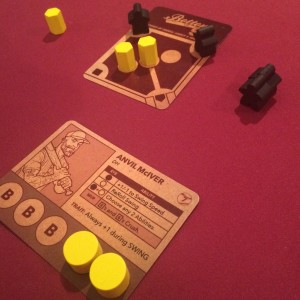 It’s the bottom of the ninth inning. The game is tied. It’s down to the home team to score 1 run to win it all. Unfortunately, the home team is staring down the league’s best closer. A dice game for 2 players, Bottom of the Ninth brings all the excitement of the final 3 outs of a baseball game into a compact 5 minute game session. With variable player strengths, bluffing, and dice-rolling, only the pitcher knows whats coming… and the batter needs to kept his eyes peeled.
It’s the bottom of the ninth inning. The game is tied. It’s down to the home team to score 1 run to win it all. Unfortunately, the home team is staring down the league’s best closer. A dice game for 2 players, Bottom of the Ninth brings all the excitement of the final 3 outs of a baseball game into a compact 5 minute game session. With variable player strengths, bluffing, and dice-rolling, only the pitcher knows whats coming… and the batter needs to kept his eyes peeled.
You play as either the home team trying to score the game-winning run or the visitors attempting to go three-up, three-down and send it into extras (But, in this case, you win.) As the pitcher, you are selecting your pitch using the two tokens for location and direction, while as the batter, you are trying to guess the pitch and get men on base or crush that elusive walkoff dinger. The pitcher and batter then roll dice to determine if the ball is a hit, strike or a ball. If the batter gets a hit, both players simultaneously roll dice looking to roll a 5 or 6 first in order to record the out or contrarily get on base.
Steebin: This game is tons of fun. It offers up the same feeling of tension as you would while playing (or watching) a real game when it is all on the line. Each game you play will tell a different story. After Biff and I played, we had fun recalling the events to the others about how our game ended. Biff struck out my first two batters. Then, I was able to get back-to-back singles. With two men on, Biff throws a strike, high and away. I toss my dice and boom a natural six. All I needed was to roll another six to crush a three-run, game-winning bomb. I shook the die in my hand, sweat dripping from my brow. I tossed the die. As it rolled in slow-motion, I could visualize the six in my mind and taunting Biff as I touched ‘em all on my walk-off victory lap. The dice stopped. A…two. I had struck out swinging. I want to play this again…right now! (Editor’s Note: This dramatic Hallmark story was brought to you by the number 2 and the letter “W”…for wrong. Steebin should not have struck out swinging. It was technically a single. Put a big old asterisks next to Biff’s win.)
This game, in its current state, was pretty polished and well thought out. As the batter, it seemed like all the odds were against me. I would like to see some hitters have an added second die to help fight off strikes, maybe add in a foul off or maybe even a bunt or something like that to help the batter a little more. But, I can see how the fatigue would help mitigate the pitcher from being overpowered and constantly firing his chin music. Will be looking forward to adding this to my collection some day.
All Hands, Brace for Impact!
Designer: Nick Ferris | Players: 2-12 | Time: 10 mins | Rules: N/A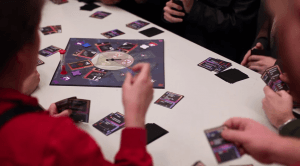
Space: the final frontier. This is a game about a doomed space station. It’s 10 minute mission: to survive a massive enemy attack. That’s it. There’s no time for anything else! Who is in charge around here?! How in the heck do I repair this hull breach?!
Tiff: It wouldn’t be a convention if I didn’t get roped into playing something very far outside of my comfort zone and All Hands, Brace for Impact! is that game. This is a real-time, cooperative game where player interaction is the central focus of the game play. As the crew of the space station, you are working against a timer and one evil alien player who is constantly sending in enemy ships to attack the vital systems of the station, such as life support. You have a hand of cards that depict a mixture of orders and responses to orders. You must monitor the status of your station and shout out the necessary orders to repair damage and fight back against the aliens. You will only be successful if someone else has the correct response, otherwise you may have to say “All hands, brace for impact!” and draw new cards.
Like most real-time games, this one was chaotic and frantic, which in turn makes it incredibly thematic. It was also so impossibly hard! I played twice and I don’t think my crew even came close to surviving once. That might be due, in part, to me being a little shy around strangers. This game cannot abide holding back. You have to be ready and willing to yell out what you need, while at the same time keeping an ear open for your fellow crewmates. It might need some tweaking to scale back the difficulty, but I dig the theme and would probably enjoy playing it with a group of friends in the comfort of my own home.
Space Station Zero
Designer: Kevin Kulp | Players: 2-4 | Time: 40 mins | Rules: N/A
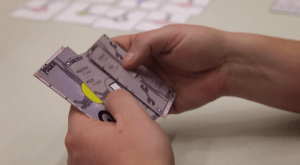 There is a derelict space station that you have been hired by… some corporation… to help research and repair the damaged systems. This is accomplished by using the available cards in the field and in your hand to create circuits. These circuits must connect to a symbol of the same type from the start to the end of the circuit. There is also an ability to steal/borrow your opponent’s cards to use as tools that give you special powers and abilities to manipulate the field and make your connections. You are awarded money for the different types of symbol cards that you control at the end of the game.
There is a derelict space station that you have been hired by… some corporation… to help research and repair the damaged systems. This is accomplished by using the available cards in the field and in your hand to create circuits. These circuits must connect to a symbol of the same type from the start to the end of the circuit. There is also an ability to steal/borrow your opponent’s cards to use as tools that give you special powers and abilities to manipulate the field and make your connections. You are awarded money for the different types of symbol cards that you control at the end of the game.
Kelly B!: This game was confusing. There is no escaping it. It could be the way the rules were presented or it might just be that the game is confusing. I think sometimes when someone knows what they’re doing (i.e. they designed the game), they don’t always explain everything in the most effective manner. Either way, I appreciated that the game had a puzzle component in that to collect cards, and subsequently money, you had to work out pathways and connections across the board. Collecting cards allows you to gain expertise, which means your circuits can be shorter, but when it came to the use of tools and taking cards from other players, I felt like I was completely winging it and then, the next thing I knew, the game was over. I can’t be totally mad because I won, but this game still makes little sense to me, even after pondering it for a few days. I would give this game another shot, but I’m really just not sure how I feel about it.
Steebin: This game was take it or leave it for me. It had some interesting decision points and the puzzle aspect of trying to make the connections was pretty fun. I just wasn’t sure what exactly my goal was as I was playing the game. I thought I was supposed to collect multiples of the same symbol at first then was told that it needs to be all different to gain the most points. I think unfortunately we did not have the rules explained very well and were kind of told as we went along. It is one of those games where you struggle through it once to see what happens at games’ end, then you say, “Oh. I get it!?” and go off to play something else.
The Wolf and The Fox
Designer: Matt Riddle & Ben Pinchback | Players: 2-4 | Time: 30 mins | Rules: N/A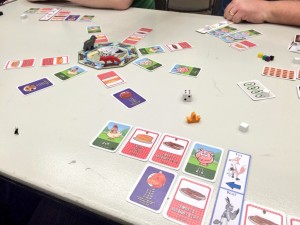
The Wolf and the Fox is a German fairy tale involving a greedy, gluttonous wolf living with a fox. In the game players are rolling a pool of dice and choosing one to move either the wolf or the fox around the central roundel; or as Matt and Ben have coined it the “Roll-del.” Each roundel space has 2 randomly distributed cards. Whatever space the animal lands on, you will take those two cards and place them in your personal tableau on either the fox side or the wolf side depending on the animal you moved to collect them. Cards placed on the fox’s side are safe however, cards collected with the wolf are susceptible to the farmer stealing them back. Players gain points at the end of the round and scores will escalate each round as your tableau builds and allows you to combo off previously collected cards. The player with the most points at the end of the game wins.
Dan: If you follow our podcast, you will know that The Tortoise and the Hare from IELLO’s Storybook Series has slowly become one of my favorite filler games. The Wolf and the Fox follows suit in a similar vein – its a kids game that adults can find enjoyment in. I really enjoyed the “roll-del” and the tableau set-building aspects of the game. The game introduces light combos that gives you a sense of purpose as you move the animals about the board (pancakes need butter…it’s that intuitive!) One comment I made after playing the “adult” version of the game was that the risk in using the wolf to collect items was minimal and didn’t factor at all in to my decision making. While I know its a kid’s game at heart, I would have liked to see just a little more “bite” which would create an additional decision point or two for me. All in all, The Wolf and the Fox was a great family-style game that anyone in the family could pick up and enjoy.
Wombat Rescue
Designer: Matt Wolfe | Players: 1-5 | Time: 60 mins | Rules: N/A
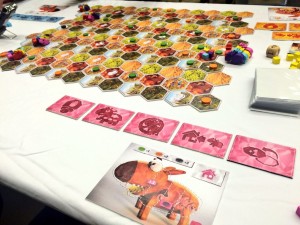 Did you know wombats poop in the shape of a cube? It’s true! Wombats have an excellent sense of smell, but extremely poor eyesight. Scientists believe they use their poop cubes to create smell areas that help them navigate their territory, and because wombat poop is flat on all sides, they don’t have to worry about it rolling around or shifting position.
Did you know wombats poop in the shape of a cube? It’s true! Wombats have an excellent sense of smell, but extremely poor eyesight. Scientists believe they use their poop cubes to create smell areas that help them navigate their territory, and because wombat poop is flat on all sides, they don’t have to worry about it rolling around or shifting position.
In Wombat Rescue, you play the eldest or lead wombat of a group of wombats (called a wisdom). A dastardly dingo has stormed your burrow and scared away four of your baby wombats. To save them, you must create new smell areas that will lead them home. You will create smell areas by eating and digesting food so that you can poop out another cube and expand your smell area. The first wombat to rescue all of its babies wins!
Dan: I have been trying to play Wombat Rescue since reading reports out of Unpub 4 last year. I was immediately drawn to the extremely unique theme of pooping cubes to help your wombats traverse the board. We were able to squeeze in a 5 player game of this and the wait was well worth it! You will need to time your digestion, along with your movement, to optimize your smell areas and increase your range of controlled movement. Outside of your smell area you are travelling blind and this may cause you to wander off your preferred path. The gradual build up of your smell area is such an intriguing mechanic; and once that poop engine is going the game moves at a much more rapid pace. On top of the unique theme and mechanics sits the amazing papercraft artwork of Mateusz Szulik, who also did the art for Waggle Dance. This game is the complete package for me and I cannot wait to get my hands on a copy of it later this year.




